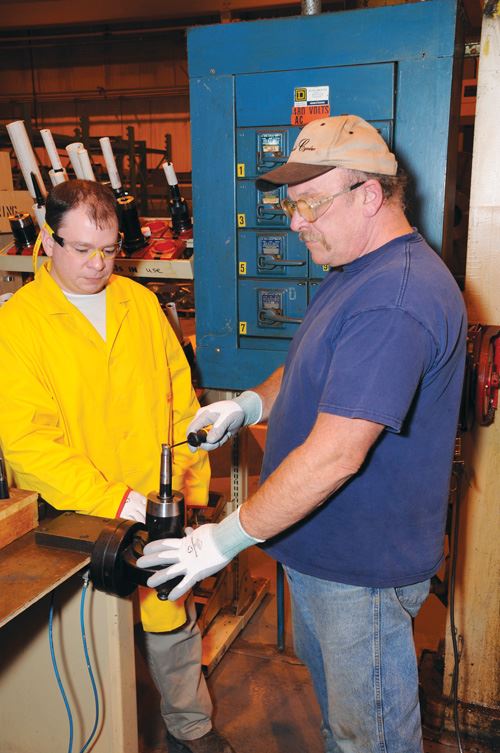Tooling Supplier Expertise Lends Competitive Edge
Even a shop that is committed to continually optimizing processes might struggle with the time and effort required to stay abreast of the latest technology developments. One manufacturer, however, has taken steps toward eliminating this problem by holding a cutting tool manufacturer responsible for improvements.
As many manufacturers can attest, process optimization is a never-ending job, especially in the cutting tool arena. By the time one solution has been successfully implemented, some new innovation might very well offer even higher levels of performance. Even a manufacturer that recognizes the importance of evaluating how the latest technology can improve operations might struggle with committing the resources required to do so.
Dresser-Rand, a provider of rotating equipment solutions, has taken steps to eliminate this problem at its Olean, New York campus. By leveraging the knowledge of cutting tool manufacturer Sandvik Coromant through an ongoing partnership, the company can continually optimize its tooling and cutting processes while maintaining focus on its core competency of creating and providing innovative products.
Established in 1912, Dresser-Rand’s Olean campus specializes in centrifugal compressors used for applications including oil and gas production, refining and natural gas transmission. The company’s relationship with Sandvik began in October 2006, when a tooling supervisor seeking to improve machining processes on a specific impeller component caught wind of the cutting tool supplier’s Productivity Improvement Program (PIP). Through PIP, Sandvik technicians collaborate with customer personnel to optimize their manufacturing operations. Together, they work to consolidate tooling and inserts, reduce production costs, increase machine capacity and address metalcutting problems.
"In our eyes, PIP really offered a new approach to tooling optimization," says Terry Mascho, tooling supervisor at Dresser-Rand. "It was described as a team effort, with us providing expertise on our parts and requirements and them providing expertise on tooling and cutting processes."
At the outset, seven Sandvik representatives spent a week at Dresser-Rand’s facility to work with employees and gather information on the impeller job. The company was plunge-milling the impeller’s blades with a tool that held a single insert with two cutting edges. After extensive evaluation, Sandvik designed a new plunge-milling solution that integrated two inserts, each with four cutting edges. While the custom tool was significantly more expensive than its predecessor, the PIP team estimated that it would offer substantial cost savings.
Implementing the tool would prove them correct—after testing the custom tool and determining the proper feeds and speeds, annual savings totaled approximately 1,200 hours per year. "A little improvement in a process can really add up," Mr. Mascho says. "Eliminating some cost from even a single step can turn into a significant number when you look at the big picture."
These results convinced Dresser-Rand that it would be beneficial to maintain an active and ongoing relationship with Sandvik. The company determined that the level of tooling expertise available through such a relationship would be difficult, if not impossible, to achieve and maintain internally. The new approach soon began producing results throughout the company’s facilities.
In one particular instance—which local Sandvik representative Mark Brunner says was one of the more challenging applications the team had reviewed—operators struggled with short tool life during turning operations on a part cut from duplex stainless steel. The component featured numerous interrupted cuts, and tools lasted only about 2 minutes.
After analysis, the PIP team recommended an 80-degree diamond insert incorporating a 100-degree corner that is typically not found on such an insert. After testing multiple grades and geometries to determine the optimum solution, the team adjusted the toolholder to provide a 15-degree lead as it approached the part. Tool life increased by more than 500 percent, allowing the company to run the application for nearly 15 minutes per tool.
"During the last 2 years, we’ve had Sandvik guys in to look at more processes than I can remember, and they are always completely committed to whatever we need help with," Mr. Mascho says. "There have even been a couple instances where we’ve had applications outside of their tooling offerings, and they helped us implement tooling from a competitor."
To ensure continuous progress, the two companies meet quarterly to review recent achievements and current challenges. Representatives from the local tooling distributor, Kenneth Crosby New York, also attend these meetings. The team documents cutting data from both the original and new processes for all applications that have been evaluated, and cumulative cost savings are presented annually.
"We’re constantly working to improve, and Sandvik’s knowledge has been an asset in our efforts," Mr. Mascho says.
Related Content
How to Tackle Tough Angled Pocket Milling With Two Tools
Milling a deep pocket with a tight corner radius comes with unique challenges, but using both a flat bottom drill and a necked-down finishing tool can help.
Read MoreHow to Mitigate Chatter to Boost Machining Rates
There are usually better solutions to chatter than just reducing the feed rate. Through vibration analysis, the chatter problem can be solved, enabling much higher metal removal rates, better quality and longer tool life.
Read More10 Tips for Titanium
Simple process considerations can increase your productivity in milling titanium alloys.
Read MoreBuying a Lathe: The Basics
Lathes represent some of the oldest machining technology, but it’s still helpful to remember the basics when considering the purchase of a new turning machine.
Read MoreRead Next
3 Mistakes That Cause CNC Programs to Fail
Despite enhancements to manufacturing technology, there are still issues today that can cause programs to fail. These failures can cause lost time, scrapped parts, damaged machines and even injured operators.
Read MoreThe Cut Scene: The Finer Details of Large-Format Machining
Small details and features can have an outsized impact on large parts, such as Barbco’s collapsible utility drill head.
Read More









.png;maxWidth=300;quality=90)








.png;maxWidth=300;quality=90)








.png;maxWidth=970;quality=90)